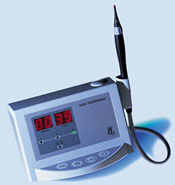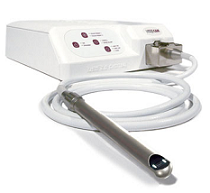|
SERVICES & TECHNOLOGY
We are pleased to offer the following services and technologies to our patients:
ORAL HYGIENE CARE
Maintaining good oral hygiene is one of the most important things you can do for your teeth and gums. Healthy teeth not only enable you to look and feel good, they make it possible to eat and speak properly. Good oral health is important to your overall well-being. Daily preventive care, including proper brushing and flossing, will help stop problems before they develop. In between regular visits to the dentist, there are simple steps that each of us can take to greatly decrease the risk of developing tooth decay, gum disease and other dental problems. These include:
The following are indications of good oral hygiene:
Back to topA dental cleaning is a professional cleaning you receive from a dentist or dental hygienist. Most dental cleanings take only between 25 and 30 minutes. Cleanings should be performed every six months to prevent excessive plaque buildup. Plaque left untreated can lead to unhealthy gums and tooth decay. A routine dental cleaning should include scaling, root planing and polishing. Scaling: this is the process of removing plaque and tartar from all tooth surfaces in a variety of methods, depending on the amount of plaque and tartar. Dental hygienists traditionally perform scaling by hand. However, new and advanced technology has lead to more modern methods such as electric scalers. This sophisticated tool allows dental cleanings to be performed more efficiently and in less time. To achieve best results, both electric and manual scaling methods are combined for dental cleanings. Root planing: this is the process of cleaning pockets in the gums to treat and prevent gum problems. Root planing is used to treat moderate to advanced gum diseases. When the gum is inflamed, gum pockets become deeper and may lose connections to the bone inside. The deeper the pockets, the easier it is for plaque deposits to become trapped and worsen gum problems. Root planing involves inserting a pointed dental tool called scalers into the gym pockets to clean plaque buildup. Depending on the degree of difficulty, root planing may take several appointments and a local anesthesia may be used to prevent pain. Polishing: this is the last step in tooth cleaning and involves finishing the surface of the teeth to make them shiny and clean. There are two kinds of polishing: air polishing and rubber tip polishing. Air polishing works by spraying high pressured water mixed with baking soda paste onto the surface of your teeth. BONDING Bonding involves adhering composite resin material that is matched to the color of the tooth, to the front of the tooth. This is performed to repair damage caused by decay, to alter the alignment of the tooth, close gaps between the teeth, or for other cosmetic purposes. First the surface of the tooth is roughened in order to accept the bonding. A gel is applied so the resin will adhere to the surface of the tooth. The composite is then placed on the tooth and the bonding agent hardens with intense light. The last step is shaping and polishing to give a lustrous finish. Back to top FILLINGS There are a variety of filling materials available including gold, silver, plastic and porcelain. The dentist will work with you to determine which material is best, depending on the extent of repair, where in the filling is needed, and cost. Each filling material is briefly explained below:
If decay or a fracture has damaged a large portion of the tooth, a crown (or "cap") may be recommended. Decay that has reached the nerve may be treated through root canal therapy or through a procedure called pulp capping. Back to top NON-SURGICAL GUM TREATMENT |
|
ADVANCED PROCEDURES CROWNS AND BRIDGES
Crowns and bridges are used to restore and enhance teeth that are damaged or to take the place of missing teeth. A crown (also referred to as a cap) is used to entirely cover a damaged tooth. A crown not only strengthens a tooth, but it can dramatically improve a tooth’s appearance, shape and alignment.
A bridge is an ideal method to fill the space created by missing teeth. A bridge is one or more artificial teeth cemented into place using the teeth on either side for support. This is an option for filling the space created by a missing tooth. Bridge work is as much an art as it is an exact science since it replaces a missing tooth both functionally and cosmetically. The materials used may be gold alloys, porcelain bonded to metal alloy, or all ceramic material made to match your natural tooth color. The choice of material depends on requirements for strength, wear, and aesthetics. Bridges and crowns are made by first taking an impression of your mouth. The impression is sent to a dental lab where your crown or bridge will be custom made to fit your mouth and match your natural tooth color. A temporary crown or bridge will be placed into your mouth until your permanent crown or bridge is ready and cemented into place. Bridges and crowns are very durable and can last a lifetime with extra care and good oral hygiene. Back to top TOOTH EXTRACTIONS
After careful examination and treatment, the dentist may advise to have a tooth extracted. Before a tooth is removed, the dentist will take an x-ray in order to understand the shape and position of the tooth and surrounding bone. Based on the degree of difficulty, we may refer you to a specialized oral surgeon. For a simple extraction, we will first apply a local anesthetic to prevent pain and discomfort. The tooth will be loosened with a tool called an elevator and then removed with dental forceps. Once the procedure is complete, the area may be closed with one or two stitches. We will then provide you with care instructions to alleviate discomfort and ensure proper healing. Back to top
ROOT CANAL TREATMENT Root canal treatment (also referred to as root canal therapy or endodontic therapy) is made necessary when an untreated cavity reaches all the way to this pulp. Treatment may also be needed when deep restorations or trauma to a tooth cause nerve damage. Once the pulp becomes infected, and can begin to eat away at the surrounding bone (this is known as an abscess). If the pulp is infected, not only is it painful but it will require treatment as it cannot heal on it's own. Symptoms that indicate the pulp has become infected may include sensitivity to hot/cold or sweets, pain, swelling, pain to biting or pressure, and a bad taste in the mouth. However, sometimes no symptoms are apparent and you may be unaware of any problem until a checkup. A root canal is performed to clean out the infected tooth pulp and disinfect the canals of the tooth. Alternate treatment would be to extract the tooth. Once the infection is resolved, the canal is filled in to prevent any further infection. Usually a core build-up and crown is recommended for restoring a tooth that has undergone root canal therapy. Back to top
DENTAL IMPLANTS To receive implants, you need to have healthy gums and adequate bone to support the implant. You must also be committed to excellent oral hygiene and regular dental visits as these are critical to the long-term success of dental implants. Back to top
This restoration method is used to restore your smile and mouth function if all your teeth have been lost. The dentures are custom created to resemble natural teeth and are positioned to take the place of natural teeth. Complete dentures are removable and may require adjustments in order to create a proper fit with the gums and mouth. A removable partial denture is a device used when one or more natural teeth still remain in the upper or lower jaw. They usually consist of replacement teeth attached go a gum-colored plastic base which is held in place in the mouth. A fixed partial denture acts the same as a removable denture, but it is cemented into place using adjacent teeth for support. New dentures may feel awkward or loose for the first few weeks until the muscles of your cheek and tongue learn to keep them in place and you are comfortable eating and speaking. Although this may require some practice you will adjust and enjoy the benefits a full mouth of teeth can provide. Back to top NIGHTGUARDS AND MOUTHGUARDS If you have decided a guard is right for you, we will take an impression of your teeth which will then be sent to a lab to make a custom fit guard. In most cases you can choose from a variety of colors and styles. On average, guards last between 3 and 10 years. Back to top |
|
COSMETIC DENTISTRY  COSMETIC DENTISTRY COSMETIC DENTISTRYCosmetic dentistry includes procedures correct imperfections or enhance the appearance of the mouth. Tooth color, alignment, spacing as well as regularity of the teeth are the characteristics that give the overall appearance. Any of these can be enhanced to provide a stunning new smile. Tooth whitening is a popular procedure to make teeth whiter and brighter, and therefore more attractive. Bleaching can be used to whitening stained and discolored teeth, or simply to enhance a dull smile. Either way, tooth whitening is a safe and relatively painless procedure ideal for most patients. Our office offers two methods of whitening: in-office whitening and tray whitening.
In-office whitening is an ideal for anyone wanting immediate results. The entire process takes place in our office in about an hour, making it the perfect choice for busy individuals. In this process, a protective gel is applied to your gums to protect the soft tissue. A special light-activated gel is then applied to your teeth and a special light or laser is used to enhance the action of the agent - making your teeth whiter and brighter. As a final step, we take impressions of your teeth to create custom trays for at home touch-ups, and give you instructions for keeping your smile bright. The result is dramatically whiter teeth that will last for years. Tray whitening is a less expensive whitening treatment you can use while in the comfort of your own home. We will first take an impression of your mouth to create a customized clear whitening trays for you to wear. Within a few days your trays will be ready to be picked up and we will show you how to apply the special bleaching material to the trays. The whitening gel trays should be worn 30-60 minutes up to twice a day. At the end of this period, you will see maximum whitening results that are nothing short of dazzling. Occasional treatment can be used at your convenience to maintain your new smile. Back to top
VENEERS |
DENTAL TECHNOLOGY
 In order to provide nothing but the best to our patients, our office uses state-of-the-art technologies in all our procedures. These new technologies allow us to treat dental cases with extreme precision, detect dental concerns at early stages, and provide stunning and customized restorations. When you visit our office you can be confident that you are receiving on the finest and most advanced in dental care. We proudly offer and use the following advanced equipment: In order to provide nothing but the best to our patients, our office uses state-of-the-art technologies in all our procedures. These new technologies allow us to treat dental cases with extreme precision, detect dental concerns at early stages, and provide stunning and customized restorations. When you visit our office you can be confident that you are receiving on the finest and most advanced in dental care. We proudly offer and use the following advanced equipment: DIAGNOdent DIAGNOdentProviding the absolute best service to our patients is of the highest importance to our office. To aid in achieving this goal, we use a new high-tech device called the DIAGNOdent. This small tool is a portable laser that allows us to detect cavities on the chewing surface of the back teeth that would have otherwise gone undetected by previous methods. Diagnosing cavities in the back of the mouth using traditional methods is difficult; studies even show that 50% of cavities are left undetected in these areas.However, the new DIAGNOdent enables us to locate and treat these cavities, putting a stop to further decay. The laser is easy to use, harmless, and will alert us with an audible signal if it detects a cavity.It will even calculate the approximate size of the cavity so we can better plan treatment. By using this device, you can rest assured that cavities will be accurately detected and treated in their infancy. To learn more about this device, click here. Back to top
ELECTRONIC CLAIM PROCESSING INTRAORAL IMAGING |
|
77 Erie Village Square, Ste 200 • Erie, CO 80516 (303) 828-5430 phone • (303) 828-5429 fax • office@eriefamilydentistry.com |
 Oral Hygiene Care
Oral Hygiene Care This powered water washes away residue and plaque while baking soda removes stains. Rubber cup polishing uses a low-speed and gentle handpiece that contains a polishing paste made of abrasive ingredients ideal for removing stains.
This powered water washes away residue and plaque while baking soda removes stains. Rubber cup polishing uses a low-speed and gentle handpiece that contains a polishing paste made of abrasive ingredients ideal for removing stains. 
 Crowns may be used to:
Crowns may be used to:


